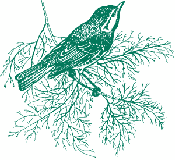The Guide to
Austin-area Birding Sites
Good places to see birds in and around Austin

Austin: A Unique Location
Within a sixty-mile radius of Austin, more than four hundred bird species have been recorded out of the over six hundred documented in the state of Texas. While this area may seem small for such a large number of birds to have been recorded, its geographic location explains the city's unique status as a hot destination for avid birders. Austin is situated along the Central Flyway, one of the four major avifaunal migration routes which criss-cross North America. Birds migrate through the Austin area almost year round (February – May and July – December). During spring, the widest variety of birds can be seen from mid-April through early May (including as many as 20 warbler species in a single day). In fall, the migration is more drawn out.
Birders also benefit from the unique geological and, subsequently, biological setting of Austin. Approximately forty million years ago, the Balcones Escarpment was formed along a fault zone which runs Northeast to Southwest through the western half of the city. The uplift resulted in the formation of two topographically unique provinces: to the west an uplifted plateau of limestone, now deeply eroded into steep sided, rocky hills (the Hill Country, also known as the Balcones Canyonlands), and to the east, the flat, lowland Blackland Prairie with broad valleys and gentle hills.
Each province harbors its
own unique combination of
soil, vegetation and animals,
including distinct bird
populations. Many bird species
reach the edge of their
distributional ranges near
the Balcones Escarpment.
Western species such as
Golden-fronted Woodpecker,
Ash-throated Flycatcher,
and Western Scrub-Jay attain
their eastern limit along
the uplift while eastern
species like the Ruby-throated
Hummingbird, Red-bellied
Woodpecker, and the Eastern
form of the Tufted Titmouse
approach the edge of their
nesting range. These bird
species, among others, may
be observed within several
miles of the escarpment.
Texas weather can be hot
and humid, so precautions
need to be taken when venturing
out to these birding sites.
Some general guidelines
include bringing sufficient
water, wearing appropriate
footgear on trails, wearing
a hat in sunny weather,
and remembering to wear
sun screen and bug spray
as needed. Most importantly,
remember to have fun and
enjoy seeing the birds!
Austin-area Birding Sites
Texas Parks and Wildlife Department
4200 Smith School Road
Austin, TX 78744
or send a message to: nature@tpwd.texas.gov